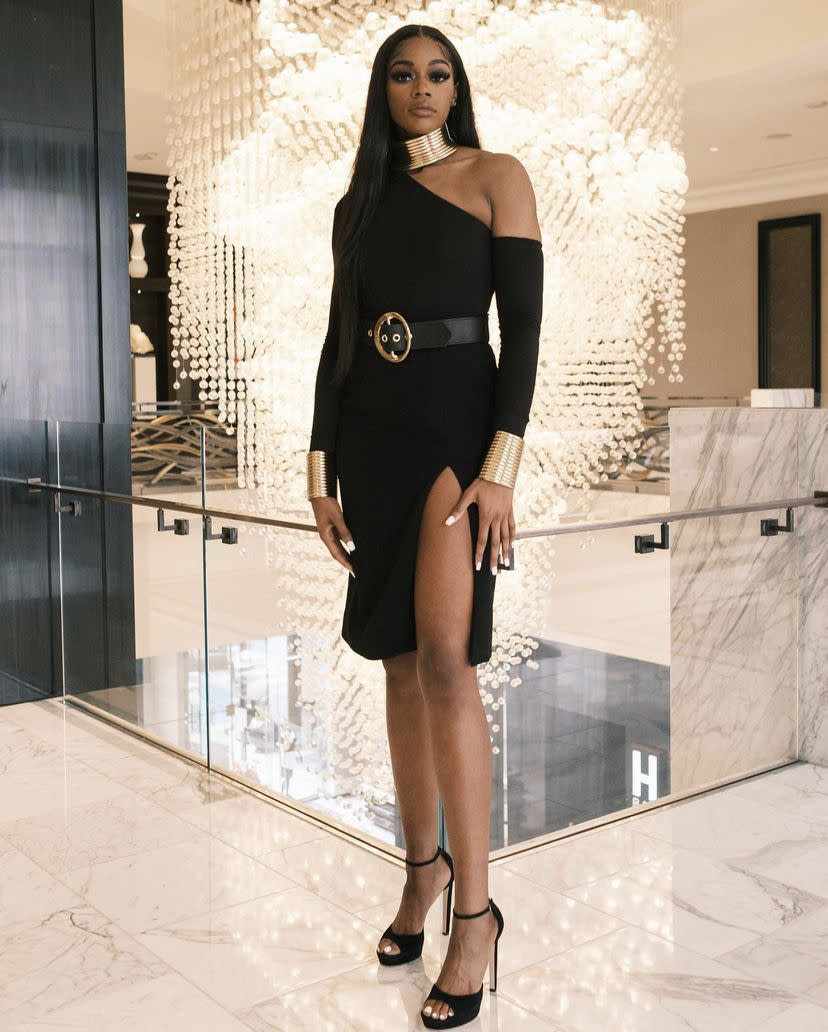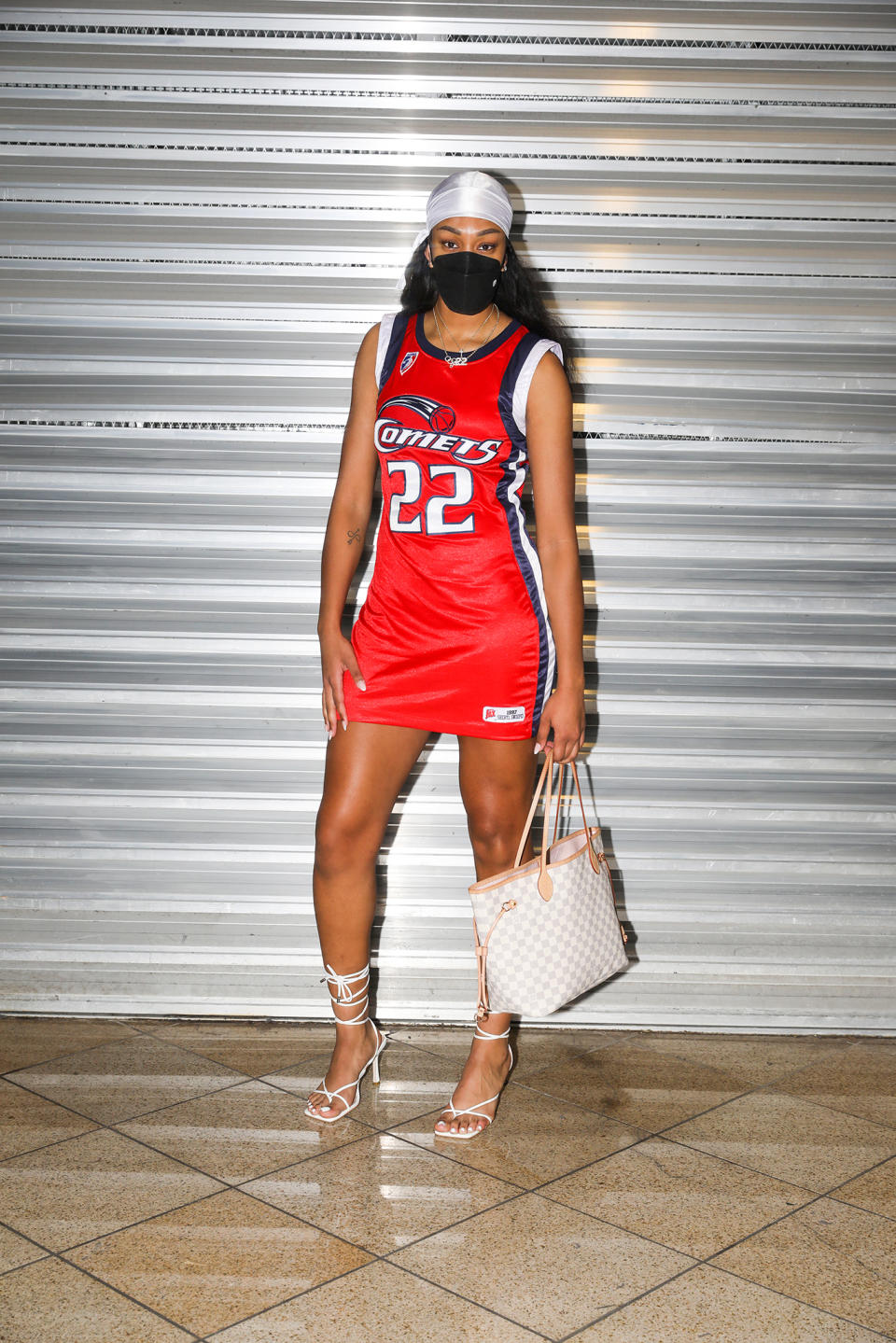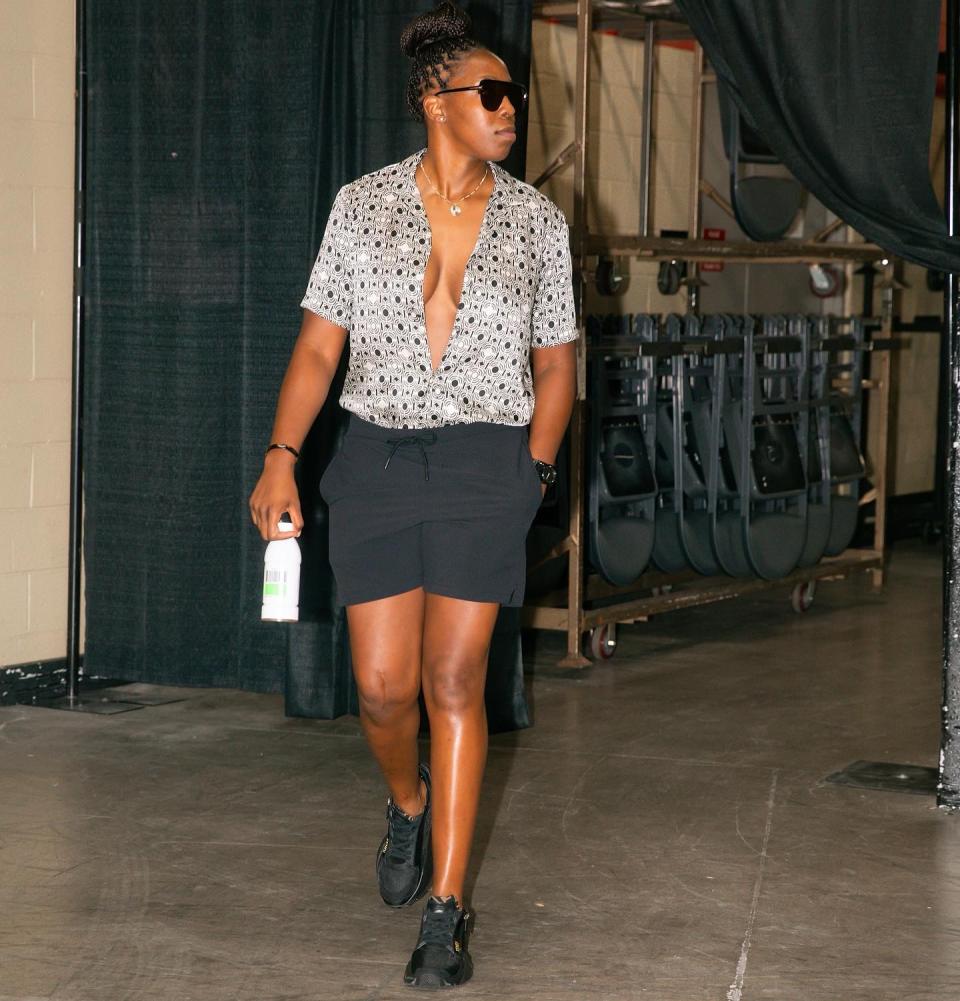Is the WNBA a Missed Fashion Opportunity?
- Oops!Something went wrong.Please try again later.
- Oops!Something went wrong.Please try again later.
- Oops!Something went wrong.Please try again later.
- Oops!Something went wrong.Please try again later.

Can the WNBA tunnel be the new runway?
This season’s conference finals series this month between the Connecticut Sun and Chicago Sky and the Las Vegas Aces and Phoenix Mercury saw unexpected fashion moments from league stars such as Diana Taurasi, Skylar Diggins-Smith, Liz Cambage and A’ja Wilson, among others, and helped shine a spotlight on the women’s take on pro basketball’s “Tunnel Style.”
More from WWD
Wilson, the Aces star forward and 2020 WNBA MVP, has been honoring past great WNBA stars during the conference finals by wearing custom jersey dresses of players like Sheryl Swoopes, the first player to be signed in the WNBA, and Lisa Leslie, the Los Angeles Sparks star and four-time Olympic gold medalist.
Wilson, the 25-year-old Nike athlete and Olympic gold medalist, said she doesn’t like to dress “flashy,” opting to wear something comfortable. But she felt nostalgic about the jersey dress style and wanted to bring it back for this playoff series to be game-ready and to pay tribute to the stars who paved the way for her professional career on the league’s 25th anniversary.
“Fashion allows someone’s personality to come to life,” Wilson said. “You can really identify someone’s personality by their tunnel fits.”
Wilson turned to a past collaborator who made jerseys for her to make the jersey dresses of Swoopes’ Houston Comets jersey and Leslie’s high school jersey for the Morningside Lady Monarchs in Los Angeles, where she once scored 101 points in a game in just two quarters against South Torrence High, which scored just 23 points and forfeited by halftime.
“I thought jersey dresses look cute,” Wilson said. “The Carmelo Anthony Denver Nuggets jersey dress was big in the South.”
Wilson said she doesn’t work with a stylist often, but has for the Espy’s and she may call her brother for some advice on which socks to go with. She prefers to dress comfortably in brands like Gucci and Fear of God Essentials and not overthink what she wears in order to prepare for a game. “I feel like you should be prepping for your game, but on the other hand I’d love a stylist for when you’re going to be seen.”
And with increasing viewership, social media posts and outlets like GQ sharing WNBA players’ outfits, there are more opportunities to be seen. Wilson said her jersey dress moments were the first time she had seen her photo on Instagram’s Explore page.
The posts are a glimpse into the growing number of eyes on the league. The WNBA in September said this was its most watched regular season since 2008 combined across ESPN networks, including ABC, ESPN and ESPN2 and CBS Television Network. This season’s viewership was up 51 percent over 2020 and its most watched regular season game since 2012 averaged 755,000 viewers for a matchup between the Seattle Storm and Chicago Sky on Aug. 15 on ABC.
In addition, WNBAStore.com saw record growth with a 50 percent increase over 2020, with the orange WNBA logo hoodie being the bestselling item for the second consecutive season.
Last year, in the midst of protests against police brutality in the wake of the murder of George Floyd and killing of Breonna Taylor, NBA players took a step back to offer their platforms to the WNBA players who have been very vocal about civil justice in the U.S. Last year players wore T-shirts that read “Vote Warnock” to support Raphael Warnock, who was running for the U.S. Senate in Georgia, against incumbent Kelly Loffler, part-owner of the Atlanta Dream WNBA franchise. Loffler had been vocal against the league’s support of the Black Lives Matter movement. Warnock defeated Loffler to become the first Black senator from Georgia.
“Today, the WNBA sits at the intersection of sports, entertainment, culture and individuality. As a player-first league, we are proud to be celebrating 25 years of highlighting WNBA athletes’ talent, activism, energy and authenticity,” said WNBA Commissioner Cathy Engelbert. “Over the past few years we have seen a rise in viewership, fandom and broader popularity of WNBA players, due in part to their strong advocacy for social justice and bringing awareness to important and complex societal issues. Whether using their social platforms, engaging in their local communities, or turning their arena entrance into a fashion statement for their latest ‘fits,’ players continue to share their multidimensional appeal to millions of fans and serve as role models for the next generation of athletes.”

Emily Johnson
For years, many argued that the WNBA and women’s sports were unwatchable and had viewership figures to support their claim. The argument was that if brands wanted to maximize their advertising efforts, they would get more for their dollar aligning with athletes who are more popular. But the age of social media has changed the landscape. While the WNBA regular season drew its highest viewership to date, the NBA regular season drew on average 1.32 million viewers, a 25 percent decline from the pre-pandemic 2018-19 season (1.75 million). That still eclipses the WNBA’s highest-rated game from the 2021 season, however. The highest-rated NBA game of the season, a Christmas Day matchup between the Los Angeles Lakers and Dallas Mavericks, averaged 7.01 million viewers.
The television ratings coupled with websites like GQ, Bleacher Report and League Fits sharing tunnel fits give the NBA, NFL and other men’s sports more eyes. With higher optics comes higher competition from brands to get in front of athletes and higher costs to partner with athletes as well. The top WNBA stars, reigning champions and MVPs may not have the same social media following as their male counterparts, but their followings outpace any micro-influencer.
“There is an overarching theme where women are forgotten at times as a good investment and this is specific for the WNBA, but stretches to all professions,” said Sue Bird, the Seattle Storm star who won multiple NCAA championships, WNBA championships and Olympic gold medals. “This league was looked at as charity, but if someone changes that and looks at it as a place to invest, it’ll make huge splashes.”
Kesha McLeod, stylist, author, creative director and a frequent collaborator with the WNBA, said brands like Steve Madden, Aldo, Spanx and J. Crew have been supportive of the league and its players. But she claims the brands give pushback on partnerships with female athletes, including Serena Williams, a client of McLeod’s who is regarded as the top female athlete in the world today.
“About three or four years ago when I did the [‘Match My Fly’] style segment for the WNBA, it was exciting for the women to partake in it,” McLeod said. “I see the women wear Kith, Supreme, Hanifa — I would love the luxury market to embrace them more.” McLeod also mentions designer Sergio Hudson, who dressed number-one draft pick Charli Collier in a custom outfit for the WNBA Draft, as another brand or designer the athletes wear.
McLeod, who is a former basketball player herself, thinks brands have a hard time embracing female athletes in general. “They don’t know how,” she said. “They don’t understand what kind of market they’re getting into with this or don’t understand how to embrace an athlete. They don’t get it and it’s up to the stylist and media to bring awareness.”
Tennis, gymnastics and track and field have experienced similar renaissances to the WNBA. In track and field, Sha’Carri Richardson became an overnight sensation during the Olympic trials, landed a Beats headphones commercial shortly afterward despite not qualifying for the Games and was at this year’s Met Gala in Theophilio alongside longtime U.S. representative in track and field Allyson Felix, who took home a gold medal at the 2020 Tokyo Games.
Simone Biles made headlines for leaving Nike Inc. to join Athleta, saying the Gap Inc. brand is more committed to diversity and inclusion. She will develop a line for the brand. Also in tennis, Serena Williams continues to dominate in the sport, as well as in brand partnerships. In August, Sportico reported Williams’ endorsements earn her $34 million, which is second to Naomi Osaka, who earns $50 million in endorsements. Osaka is leading the next generation of tennis players following in Williams’ footsteps like Coco Gauff and Sloane Stephens, who was also at this year’s Met Gala with Osaka.
The top six highest-paid female athletes compete in tennis, gymnastics and golf. The seventh highest earner, Alex Morgan, plays for the USWNT and National Women’s Soccer League team Orlando Pride, and the ninth highest earner, Mikaela Shiffrin is an alpine skier. Basketball did not make the top 10.

Kyle Lumague
“Athletes in general retain enormous power and clout, and will continue to be central to how brands, luxury, mass and beyond look to promote,” said James Denman, executive director, strategy and digital innovation at Yard NYC. The company has partnered with the likes of Coco Gauff and Sofia Kenin, as well as the U.S. Tennis Association to showcase the next generation of American players.
“Tennis and luxury brands have a long lineage — which continues to this day,” Denman said. “But as the game opens up, and a new generation of stars take the stage, different brands and younger brands would be smart to engage with tennis players. Naomi Osaka and the Sweetgreen partnership point the way to a much broader, more interesting remit for tennis players beyond just sponsoring the likes of Nike, Uniqlo, Rolex or Tag [Heuer].”
He added, “For fashion brands, non-male athletes are going to have more and more impact. Even if you think within the context of genderless clothing — it doesn’t matter who is in the clothes, but about what the athlete represents while wearing them. If you take a brand like Thom Browne, who has surprisingly pushed into sports as a marketing opportunity, you see everyone from Russell Westbrook, to Barcelona FC to Ashlyn Harris in the brand. There is a clear bright line that appeals to these athletes in a brand like that: a subversion of identity, formalizing sporting tropes. When handled with intelligence, athletes in fashion brands is a brilliant, subversive opportunity.”
Lauren Varvara, creative director at Saatchi & Saatchi, a partner of the WNBA, agrees with Denman that non-male athletes represent great opportunity for brands.
“Non-male athletes are a well of untapped potential for fashion brands,” she said. “For starters I can think of no better group of people than athletes known for being strong and powerful above all else to help emphasize a healthier body image among models and the people who see them.”
Saatchi & Saatchi worked with the WNBA on the league’s “Count It” campaign, celebrating its milestones through specially themed events and promotions. Varvara said the league and fashion have been synonymous since Sheryl Swoopes’ first Nike sneakers, Air Swoopes, when the athlete became the first woman to have a signature athletic shoe.
“We’ve also seen players getting more attention for their street style during pregame entrances that garner a ton of attention on social media,” Varvara added. “I find athletes to be among the most believable influencers when it comes to marketing because unlike actors, we tend to view athletes as regular people who just happen to be insanely talented. There’s less of a sense of being ‘sold to’ so the marketing that comes from them has a greater degree of authenticity. Plus, it’s always nice to see the off-the-court personas we don’t have access to during games or interviews.”
What are fashion brands doing about the WNBA? Players have touted some luxury, men’s wear and fast-fashion brands as their favorites, including Gucci, Dior, Fendi, Market, Fear of God Essentials, Daniel Patrick and Zara, among others.
“I feel the WNBA is an untapped market for fashion brands,” said Keiser Clark designer Marc Keiser. The designer met Bird through her partner Megan Rapinoe and they have worked together ever since. “Many men’s brands like Fear of God and Rhude, they’re not marketing or advertising themselves as a unisex brand. Speaking for my brand, everything we design I also picture how it’ll look on a woman because I do think that’s a huge market that many brands can so easily ostracize.”
Keiser said athletes Rapinoe and Bird drive traffic and sales for his brand, and by working with WNBA athletes or female athletes in general, brands are reaching everyday consumers and young girls who look up to WNBA players. “WNBA players have a genuine audience,” Keiser said. “Fans pay attention to them maybe twice as much as the men’s athlete.”
He also understands there may be an issue with fits, but this is where men’s brands thrive. Las Vegas Aces guard Chelsea Gray considers her style to be fluid and said she pairs men’s shirts with women’s styles. In one outfit, she paired a floral men’s shirt from Zara with women’s shorts and Fendi shoes. She often shops Fendi’s men’s offering. She also likes shopping Saint Laurent and Alexander McQueen, Adidas tracksuits, and shirts supporting HBCU schools.
“My style is so fluid,” Gray said. “All of the women’s styles won’t fit me right, and men’s, too, but I’m able to mix and match. I’ve had contact with a stylist and we’ve talked about different styles and what looks good. My wife helps me a lot, but my everyday tunnel look is me creating something.”
Many WNBA stars have stepped out as champions of style, such as Skylar Diggins-Smith, the Phoenix Mercury guard who is the first female athlete to sign with Roc Nation Sports in 2013, Dallas Wings guard Arike Ogunbowale, who is an ambassador for sneaker community website SoleSavy and launched merchandise with Pwrfwd, as well as Bird.

Courtesy Photo
Bird has had arguably the most talked about fashion moments out of all of the players. She rocks brands like Essentials, Market and Keiser Clark, and has a friendly sneaker rivalry with the NBA’s top sneakerhead P.J. Tucker. But her most notable moment was off-court when she cohosted the ESPY’s in 2020 with Rapinoe in Black designers, including Pyer Moss, Fear of God and Christopher John Rogers.
“The [ESPYs looks] were a combination of myself, Megan, [stylist] Karla Welch and Ben Kushner at Nike,” Bird said. “Megan and I talked about it, Karla was on board and made it come to life and Ben did all of the footwear. We wanted to highlight designers who don’t get highlighted.”
Bird was drafted to the WNBA in 2002 and witnessed changes over close to 20 years of the league’s 25-year history. She and Gray explained that in the early days the league had a dress code that was “limited” and didn’t allow for jeans, T-shirts or sneakers, which is similar to how the late David Stern, former NBA Commissioner, implemented a dress code for male players.
Gray said, “Coming into the league, they said the style needs to be more business casual. You would see slacks and not as many jeans. You wouldn’t see sweats in the tunnel. You’d see formalwear, but also people weren’t taking tunnel photos as much.”
“We kind of copy and pasted their dress code,” Bird added of the NBA dress code. “I think when they took jeans out we had a mini revolt. The dress code was really limiting and that really hurt a lot of fashion in the WNBA.”
Bird mentioned former WNBA point guard Cappie Pondexter as one of the league’s more stylish players since she was drafted in 2006, and sees the NBA “tunnel fits” as the gateway for players in both leagues to push their style.
“Seeing women in what they feel good in and comfortable in,” Bird added, “that’s how it is for all women out there.”
Bird said she may browse Acne Studios, for example, but check out the men’s offering. Like Gray, she’s helping to popularize the new version of mixing high fashion and fast fashion — mixing women’s and men’s styles un-ironically.
“What we see in the world today, our league is at the intersection of all of those things,” Bird said. “We had a player recently come out as trans. We’re a whole marketplace that has not been tapped into. To get in now and start those relationships that will pay dividends in three to five years and that’s the opportunity. We have a lot of players that are tall and for tall women in general it’s hard to find pieces in their size. A whole untapped world.”
Best of WWD
Sign up for WWD's Newsletter. For the latest news, follow us on Twitter, Facebook, and Instagram.

